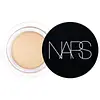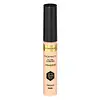NARS Cosmetics Soft Matte Complete Concealer Versus Max Factor X Facefinity All Day Flawless Concealer
What's inside
What's inside
 Key Ingredients
Key Ingredients

 Benefits
Benefits

 Concerns
Concerns

 Ingredients Side-by-side
Ingredients Side-by-side

Dimethicone
EmollientWater
Skin ConditioningGlycerin
HumectantNylon-12
Butylene Glycol
HumectantParaffin
PerfumingDimethicone/Vinyl Dimethicone Crosspolymer
Skin ConditioningDicaprylyl Carbonate
EmollientPEG-10 Dimethicone
Skin ConditioningSorbitan Sesquiisostearate
EmulsifyingPEG-400
Emulsion StabilisingSilica
AbrasiveAluminum Hydroxide
EmollientPolysilicone-2
Microcrystalline Wax
Emulsion StabilisingCI 77120
Cosmetic ColorantDistearyldimonium Chloride
Palmitic Acid
EmollientHydrogen Dimethicone
Palmitoyl Tripeptide-5
Skin ConditioningTocopheryl Acetate
AntioxidantAscorbic Acid
AntioxidantRetinyl Palmitate
Skin ConditioningAlumina
AbrasiveSodium Acetylated Hyaluronate
HumectantTocopherol
AntioxidantPhenoxyethanol
PreservativeCI 77163
Cosmetic ColorantIron Oxides
Mica
Cosmetic ColorantCI 77891
Cosmetic ColorantDimethicone, Water, Glycerin, Nylon-12, Butylene Glycol, Paraffin, Dimethicone/Vinyl Dimethicone Crosspolymer, Dicaprylyl Carbonate, PEG-10 Dimethicone, Sorbitan Sesquiisostearate, PEG-400, Silica, Aluminum Hydroxide, Polysilicone-2, Microcrystalline Wax, CI 77120, Distearyldimonium Chloride, Palmitic Acid, Hydrogen Dimethicone, Palmitoyl Tripeptide-5, Tocopheryl Acetate, Ascorbic Acid, Retinyl Palmitate, Alumina, Sodium Acetylated Hyaluronate, Tocopherol, Phenoxyethanol, CI 77163, Iron Oxides, Mica, CI 77891
Water
Skin ConditioningIsododecane
EmollientAluminum Starch Octenylsuccinate
AbsorbentDicaprylyl Ether
EmollientDicaprylyl Carbonate
EmollientSodium Chloride
MaskingStearalkonium Bentonite
Gel FormingTri (Polyglyceryl-3/Lauryl) Hydrogenated Trilinoleate
EmulsifyingTrimethylsiloxysilicate
EmollientSilica
Abrasive2,3-Butanediol
HumectantGlycerin
HumectantCetyl PEG/PPG-10/1 Dimethicone
EmulsifyingPropylene Carbonate
SolventTriethoxycaprylylsilane
Chlorphenesin
AntimicrobialSilica Dimethyl Silylate
EmollientSodium Benzoate
MaskingBambusa Arundinacea Stem Extract
Skin ConditioningDimethylmethoxy Chromanol
AntioxidantTocopherol
AntioxidantPentaerythrityl Tetra-Di-T-Butyl Hydroxyhydrocinnamate
AntioxidantTitanium Dioxide
Cosmetic ColorantCI 77891
Cosmetic ColorantIron Oxides
CI 77492
Cosmetic ColorantCI 77499
Cosmetic ColorantWater, Isododecane, Aluminum Starch Octenylsuccinate, Dicaprylyl Ether, Dicaprylyl Carbonate, Sodium Chloride, Stearalkonium Bentonite, Tri (Polyglyceryl-3/Lauryl) Hydrogenated Trilinoleate, Trimethylsiloxysilicate, Silica, 2,3-Butanediol, Glycerin, Cetyl PEG/PPG-10/1 Dimethicone, Propylene Carbonate, Triethoxycaprylylsilane, Chlorphenesin, Silica Dimethyl Silylate, Sodium Benzoate, Bambusa Arundinacea Stem Extract, Dimethylmethoxy Chromanol, Tocopherol, Pentaerythrityl Tetra-Di-T-Butyl Hydroxyhydrocinnamate, Titanium Dioxide, CI 77891, Iron Oxides, CI 77492, CI 77499
 Reviews
Reviews

Ingredients Explained
These ingredients are found in both products.
Ingredients higher up in an ingredient list are typically present in a larger amount.
Ci 77891 is a white pigment from Titanium dioxide. It is naturally found in minerals such as rutile and ilmenite.
It's main function is to add a white color to cosmetics. It can also be mixed with other colors to create different shades.
Ci 77891 is commonly found in sunscreens due to its ability to block UV rays.
Learn more about CI 77891Dicaprylyl Carbonate comes from carbonic acid and caprylyl alcohol, a fatty alcohol. It is an emollient and gives skin a velvet feel. The sources of Dicaprylyl Carbonate may be synthetic or from animals.
As an emollient, Dicaprylyl Carbonate creates a film on the skin. This film traps moisture in, keeping your skin soft and hydrated.
Glycerin is already naturally found in your skin. It helps moisturize and protect your skin.
A study from 2016 found glycerin to be more effective as a humectant than AHAs and hyaluronic acid.
As a humectant, it helps the skin stay hydrated by pulling moisture to your skin. The low molecular weight of glycerin allows it to pull moisture into the deeper layers of your skin.
Hydrated skin improves your skin barrier; Your skin barrier helps protect against irritants and bacteria.
Glycerin has also been found to have antimicrobial and antiviral properties. Due to these properties, glycerin is often used in wound and burn treatments.
In cosmetics, glycerin is usually derived from plants such as soybean or palm. However, it can also be sourced from animals, such as tallow or animal fat.
This ingredient is organic, colorless, odorless, and non-toxic.
Glycerin is the name for this ingredient in American English. British English uses Glycerol/Glycerine.
Learn more about GlycerinSilica, also known as silicon dioxide, is a naturally occurring mineral. It is used as a fine, spherical, and porous powder in cosmetics.
Though it has exfoliant properties, the function of silica varies depending on the product.
The unique structure of silica enhances the spreadability and adds smoothness, making it a great texture enhancer.
It is also used as an active carrier, emulsifier, and mattifier due to its ability to absorb excess oil.
In some products, tiny microneedles called spicules are made from silica or hydrolyzed sponge. When you rub them in, they lightly polish away dead skin layers and enhance the penetration of active ingredients.
Learn more about SilicaTocopherol (also known as Vitamin E) is a common antioxidant used to help protect the skin from free-radicals and strengthen the skin barrier. It's also fat soluble - this means our skin is great at absorbing it.
Vitamin E also helps keep your natural skin lipids healthy. Your lipid skin barrier naturally consists of lipids, ceramides, and fatty acids. Vitamin E offers extra protection for your skin’s lipid barrier, keeping your skin healthy and nourished.
Another benefit is a bit of UV protection. Vitamin E helps reduce the damage caused by UVB rays. (It should not replace your sunscreen). Combining it with Vitamin C can decrease sunburned cells and hyperpigmentation after UV exposure.
You might have noticed Vitamin E + C often paired together. This is because it is great at stabilizing Vitamin C. Using the two together helps increase the effectiveness of both ingredients.
There are often claims that Vitamin E can reduce/prevent scarring, but these claims haven't been confirmed by scientific research.
Learn more about TocopherolWater. It's the most common cosmetic ingredient of all. You'll usually see it at the top of ingredient lists, meaning that it makes up the largest part of the product.
So why is it so popular? Water most often acts as a solvent - this means that it helps dissolve other ingredients into the formulation.
You'll also recognize water as that liquid we all need to stay alive. If you see this, drink a glass of water. Stay hydrated!
Learn more about WaterThis ingredient is a combination of red, black, and yellow iron oxide pigments. This combination of colors is usually found in foundation, because it results in a "skin" color.